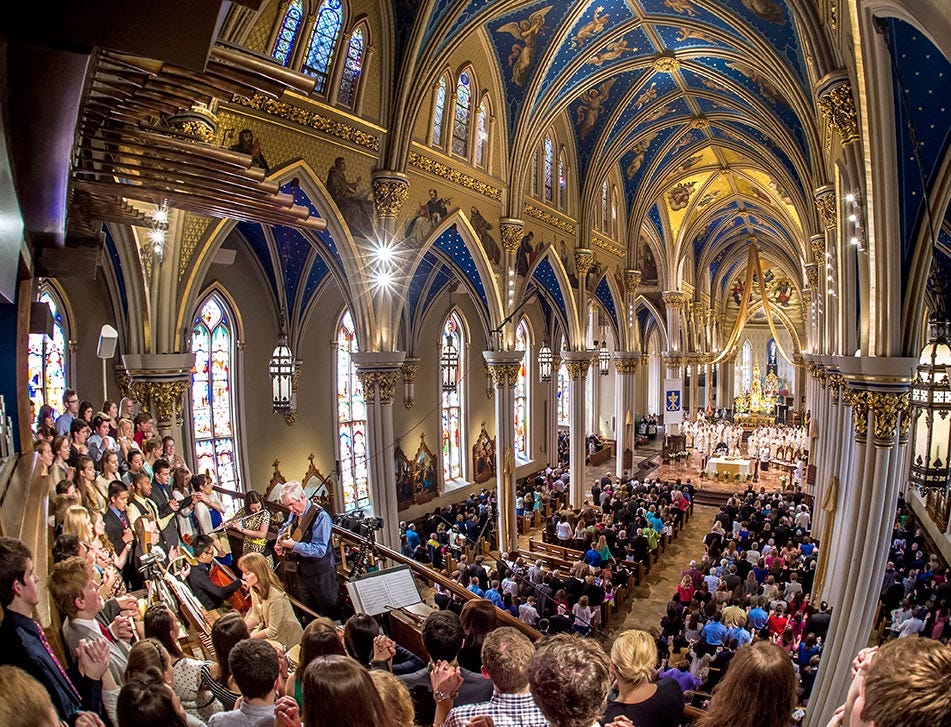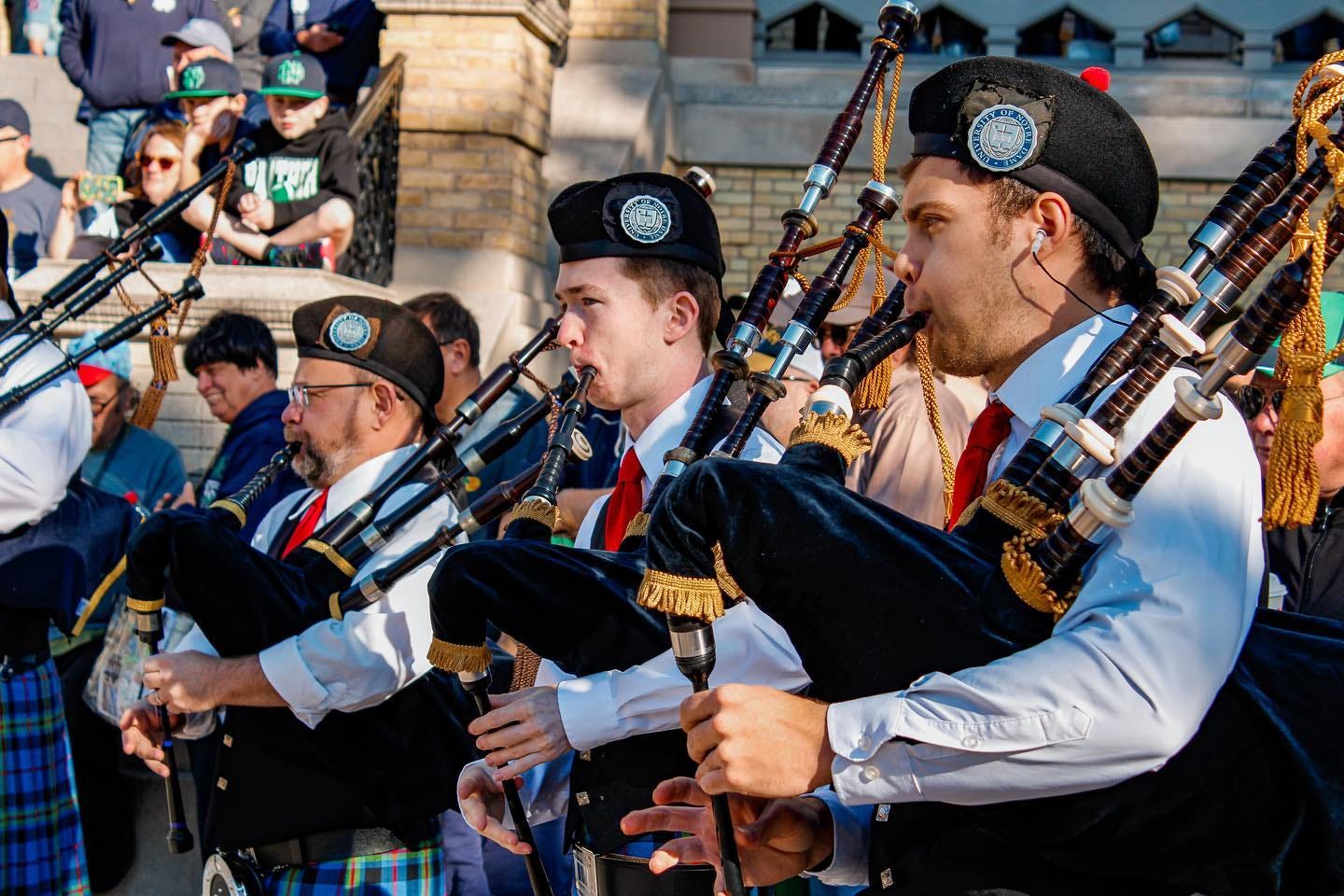Notre Dame's Topology of Tradition
What other college offers Mass immediately after every game—win or lose—in a grand basilica with the same solemnity that greets a wedding or funeral?
Through the parallax of generations—grandfather to father to child—the Golden Dome maintains its paradoxical constants, both anchor and beacon, its gilded surface catching South Bend sunlight (what little there is) like some divine signal mirror, reflecting back accumulated decades of collective reverence, each season layered upon the last in a legacy of pigskin devotion that defies mere win-loss records.
At Notre Dame, here exists a peculiar amalgam of the sacred and the secular. What other college, one wonders, offers Mass immediately after every game—win or lose—in a grand basilica with the same solemnity that greets a wedding or funeral? What other institution invites its extended family to after-game dinners in a neo-Gothic dining hall that seems to echo the refrains of some long-lost Gregorian chant? Yes, the Irish faithful process through their stations: the Grotto's flickering votives, the insistent upward thrust of Touchdown Jesus, the exhilaration of the bagpipe-and-percussion corps, the primordial foam of tailgate revelry, and the thunderous rising of 80,000 souls when the Fighting Irish breach the hashed end zone—each ritual no less significant than the last in this peculiar geography of devotion.
What strange gravitational force holds constant this network of belief across decades and generations? Through the lean years (oh those lean years!) when championships seemed as distant as medieval relics, the faithful remained. Their devotion defies ordinary logic—an unwavering commitment to both hope and expectation, where the line between victory and defeat blurs into a singular, unshakable state of perpetual anticipation. Each autumn Saturday arrives pregnant with possibility, carrying the weight of history while somehow remaining weightless, untethered from mere chronology.
Consider the topology of tradition: How many hands have traced the same paths across campus, how many feet have worn smooth the same stones, how many prayers (both desperate and triumphant) have carved invisible grooves in the air above Notre Dame Stadium? How many voices, raised in unison or solitude, have ricocheted off the limestone façades, their echoes merging with the chants of generations past? What stories have seeped into the mortar of each building; what sorrows and joys have soaked into the very soil? How many banners, raised in victory or remembrance, have flapped against the stubborn Midwestern winds, each snap of fabric marking another chapter in an unending saga? What invisible filaments connect the thousands who have walked this ground, binding them across years and distances in a web of shared memory and meaning? Yet this is no mere nostalgia machine, no dusty museum of former glories. The system remains dynamic, autopoietic, generating new layers of meaning even as it preserves the old. Just watch how the newest generation of the faithful absorbs and reflects back these ancient frequencies.
The physical constants remain: limestone and gold leaf, grass and steel, concrete and stained glass. But they serve merely as the material substrate for something far less tangible. Call it mystique, call it tradition, call it the ineffable quality that makes Notre Dame singular in the landscape of American athletics. Even in an era of conference realignments and NIL deals, when college football increasingly resembles a pure business proposition, something obstinately otherworldly persists beneath the Golden Dome.
This persistence manifests in the way alumni speak of the place, their voices taking on that particular timbre of reverence usually reserved for describing religious experiences or first loves. It shows in the way generations of families pass down this peculiar inheritance, this membership in a community that transcends mere fandom. The Irish faithful don't simply watch football; they participate in something approaching the metaphysical.
And now, as the team stands poised on the precipice of another potential championship, that familiar voltage charges the air. But win or lose, the deeper current remains undisturbed. The mystique of Notre Dame football exists independent of any single season's outcome, operating on a frequency that resonates with something fundamental in the American experience: something about tradition and faith, about community and continuity, about believing in something larger than oneself, and not leaving God out of it! The Dome still gleams, the grotto candles still flicker, and somewhere another young fan is being inducted into this most peculiar and persistent of athletic faiths.
Michael S. Rose, a member of the Notre Dame family, is author of The Art of Being Human (Angelico) and other books. His articles have appeared in dozens of publications including The Wall Street Journal, Epoch Times, New York Newsday, National Review, and The Dallas Morning News.








I didn’t watch the game last night, when they beat Penn State in the Orange Bowl, but now after reading your wonderful article I have no choice but to watch the championship game! My fifth and youngest son is playing college football here in town, Northern Kentucky, and boy oh boy, would I love to see him try to walk on at Notre Dame – he could do it in every way shape and form… As an incredible athlete, as a hard-working, dedicated student, and most importantly, as a stellar(in mama‘s opinion) Traditional Catholic young man… sigh…
God’s Will and Go Irish!